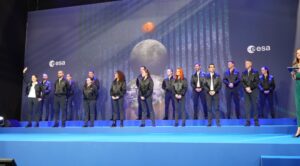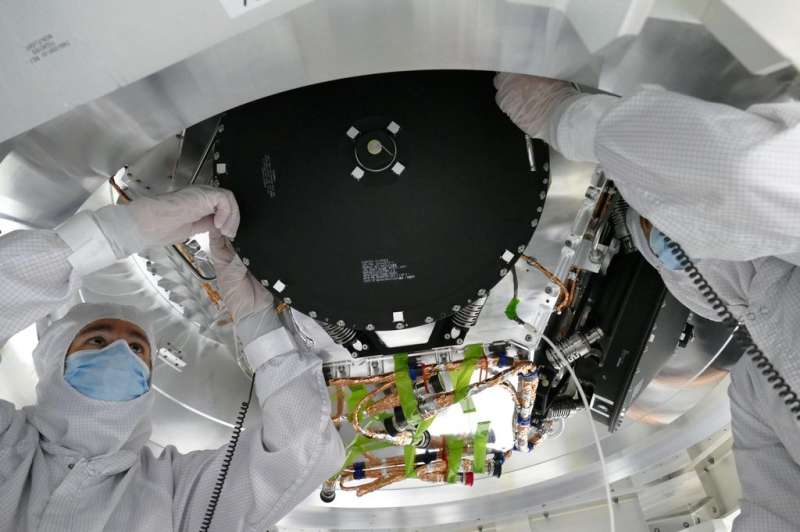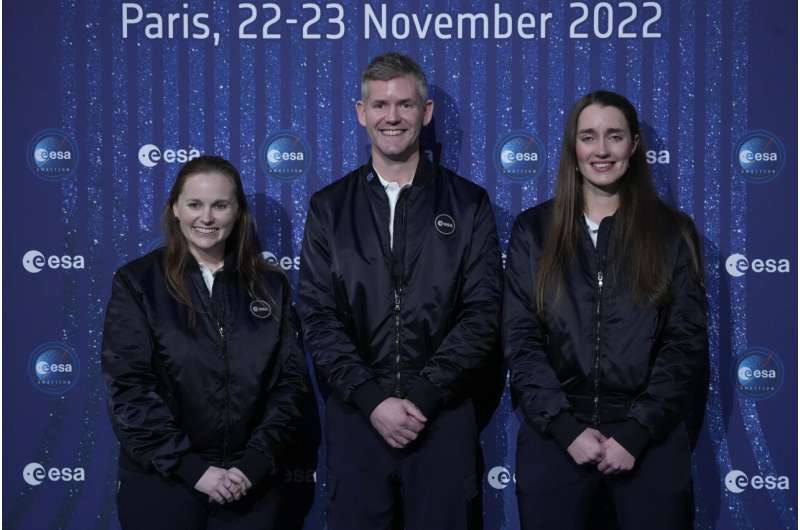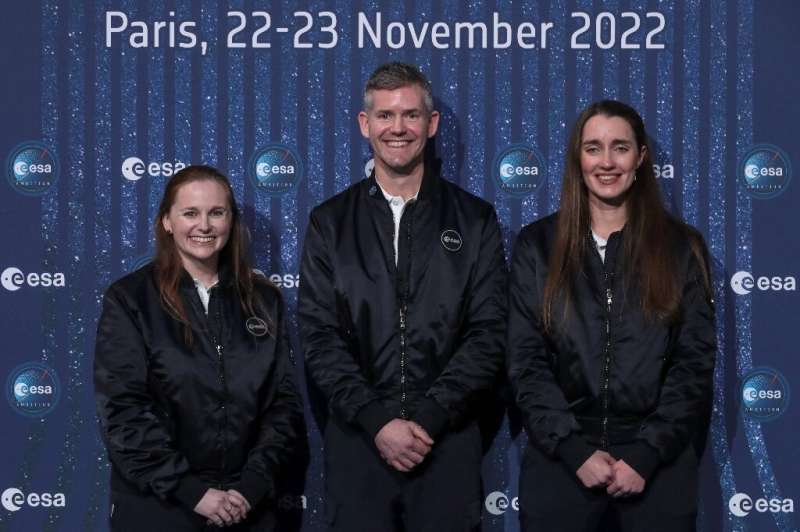SpaceX Falcon 9 carries Eutelsat communications satellite in final launch
Thursday, 24 November 2022 03:39 A SpaceX rocket carrying a communications satellite blasted off from Cape Canaveral, Fla., Tuesday night on a mission that will allow improved internet connectivity for passengers aboard ships and planes.
The Eutelsat-10B satellite lifted off from Space Launch Complex 40 atop the Falcon 9 rocket at 9:57 p.m. before assuming a super synchronous geostationary transfer orbit around the Ear
A SpaceX rocket carrying a communications satellite blasted off from Cape Canaveral, Fla., Tuesday night on a mission that will allow improved internet connectivity for passengers aboard ships and planes.
The Eutelsat-10B satellite lifted off from Space Launch Complex 40 atop the Falcon 9 rocket at 9:57 p.m. before assuming a super synchronous geostationary transfer orbit around the Ear NASA selects Rocket Lab to launch TROPICS Mission
Thursday, 24 November 2022 03:39 Rocket Lab USA, Inc. (Nasdaq: RKLB) has been selected by NASA to launch the Time-Resolved Observations of Precipitation Structure and Storm Intensity with a Constellation of Smallsats (TROPICS) mission, as part of the agency's Venture-class Acquisition of Dedicated and Rideshare (VADR) launch services contract.
Rocket Lab will launch the TROPICS mission, which is part of NASA's Earth Syste
Rocket Lab USA, Inc. (Nasdaq: RKLB) has been selected by NASA to launch the Time-Resolved Observations of Precipitation Structure and Storm Intensity with a Constellation of Smallsats (TROPICS) mission, as part of the agency's Venture-class Acquisition of Dedicated and Rideshare (VADR) launch services contract.
Rocket Lab will launch the TROPICS mission, which is part of NASA's Earth Syste European Service Module powering Orion to the Moon and back
Thursday, 24 November 2022 03:39 The European Service Module is powering Orion around the Moon and back, providing propulsion, temperature control, electricity as well as storage and delivery for essential supplies such as fuel, water and air. This first Artemis mission is an uncrewed test mission, putting the spacecraft through its paces preparing to send astronauts forward to the Moon.
After liftoff at 07:47 CET (06:47
The European Service Module is powering Orion around the Moon and back, providing propulsion, temperature control, electricity as well as storage and delivery for essential supplies such as fuel, water and air. This first Artemis mission is an uncrewed test mission, putting the spacecraft through its paces preparing to send astronauts forward to the Moon.
After liftoff at 07:47 CET (06:47 A picture is worth a thousand words
Thursday, 24 November 2022 03:39 From the image Perseverance recently took at Yori Pass, we can see that there are gray rocks scattered on top of a tan colored rock surface below. What do these different colors tell us? As planetary geologists, our job is to figure out through physical and chemical observations the story that these rocks tell us about Yori Pass and its place within the delta in Jezero Crater. Color is one of th
From the image Perseverance recently took at Yori Pass, we can see that there are gray rocks scattered on top of a tan colored rock surface below. What do these different colors tell us? As planetary geologists, our job is to figure out through physical and chemical observations the story that these rocks tell us about Yori Pass and its place within the delta in Jezero Crater. Color is one of th New research reveals space debris, invisible meteors and near-Earth asteroids
Thursday, 24 November 2022 03:39 In a new thesis from the Swedish Institute of Space Physics and Umea University, unique methods for the analysis of radar data and simulations of meteoroids in the solar system are presented. The methods have been applied to confirm the existence of rare high-altitude meteors as well as to measure space debris from the Kosmos-1408 satellite. On November 25, Daniel Kastinen defends his doctoral t
In a new thesis from the Swedish Institute of Space Physics and Umea University, unique methods for the analysis of radar data and simulations of meteoroids in the solar system are presented. The methods have been applied to confirm the existence of rare high-altitude meteors as well as to measure space debris from the Kosmos-1408 satellite. On November 25, Daniel Kastinen defends his doctoral t Orion Exits the Lunar Sphere Of Influence
Thursday, 24 November 2022 03:39 On the eighth day of its mission, Orion continues to travel farther away from the Moon as it prepares to enter a distant retrograde orbit. The orbit is "distant" in the sense that it's at a high altitude from the surface of the Moon, and it's "retrograde" because Orion will travel around the Moon opposite the direction the Moon travels around Earth.
Orion exited the gravitational sphere of
On the eighth day of its mission, Orion continues to travel farther away from the Moon as it prepares to enter a distant retrograde orbit. The orbit is "distant" in the sense that it's at a high altitude from the surface of the Moon, and it's "retrograde" because Orion will travel around the Moon opposite the direction the Moon travels around Earth.
Orion exited the gravitational sphere of Many planets could have atmospheres rich in helium, study finds
Thursday, 24 November 2022 03:39 For centuries, no one knew if we were alone in the universe-or if there were even other planets like ours.
But thanks to new telescopes and methods in the past decades, we now know there are thousands and thousands of planets out there circling faraway stars, and they come in all sorts of shapes and sizes-large and small, rocky and gaseous, cloudy or icy or wet.
A study by scientists
For centuries, no one knew if we were alone in the universe-or if there were even other planets like ours.
But thanks to new telescopes and methods in the past decades, we now know there are thousands and thousands of planets out there circling faraway stars, and they come in all sorts of shapes and sizes-large and small, rocky and gaseous, cloudy or icy or wet.
A study by scientists Astronomers observe intra-group light - the elusive glow between distant galaxies
Thursday, 24 November 2022 03:39 An international team of astronomers have turned a new technique onto a group of galaxies and the faint light between them - known as 'intra-group light' - to characterise the stars that dwell there.
Lead author of the study published in MNRAS, Dr Cristina Martinez-Lombilla from the School of Physics at UNSW Science, said "We know almost nothing about intra-group light.
"The brightes
An international team of astronomers have turned a new technique onto a group of galaxies and the faint light between them - known as 'intra-group light' - to characterise the stars that dwell there.
Lead author of the study published in MNRAS, Dr Cristina Martinez-Lombilla from the School of Physics at UNSW Science, said "We know almost nothing about intra-group light.
"The brightes The new astronauts selected by the European Space Agency
Thursday, 24 November 2022 03:39 The European Space Agency named five new career astronauts Wednesday, as well as the world's first recruit with a disability and 11 other reserve astronauts who will have to wait for their chance to go to space.
- Sophie Adenot -
The 40-year-old French engineer has flown 3,000 flight hours as a helicopter test pilot.
Her masters at MIT in the United States included work on how to des
The European Space Agency named five new career astronauts Wednesday, as well as the world's first recruit with a disability and 11 other reserve astronauts who will have to wait for their chance to go to space.
- Sophie Adenot -
The 40-year-old French engineer has flown 3,000 flight hours as a helicopter test pilot.
Her masters at MIT in the United States included work on how to des D-Orbit signs payload hosting contract with SpacePNT
Thursday, 24 November 2022 03:39 The space transportation and logistics company D-Orbit has announced the signing of a hosted payload contract with SpacePNT, a Swiss company specialized in the design and manufacturing of low cost high-accuracy GNSS receivers for the New Space satellite market.
The contract covers the integration of a new GNSS receiver prototype into ION Satellite Carrier, D-Orbit's proprietary orbital tra
The space transportation and logistics company D-Orbit has announced the signing of a hosted payload contract with SpacePNT, a Swiss company specialized in the design and manufacturing of low cost high-accuracy GNSS receivers for the New Space satellite market.
The contract covers the integration of a new GNSS receiver prototype into ION Satellite Carrier, D-Orbit's proprietary orbital tra ESA announces new astronaut class
Wednesday, 23 November 2022 22:31
ESA has selected its first new astronauts in more than a decade, although long-term flight opportunities for the agency’s astronaut corps remain uncertain.
The post ESA announces new astronaut class appeared first on SpaceNews.
NASA's Europa Clipper gets its wheels for traveling in deep space
Wednesday, 23 November 2022 19:19
The enormous spacecraft that will head to Jupiter's moon Europa uses four large reaction wheels to help keep it oriented.
Just as NASA's Mars rovers rely on robust wheels to roam the Red Planet and conduct science, some orbiters rely on wheels, too—in this case, reaction wheels—to stay pointed in the right direction. Engineers and technicians at NASA's Jet Propulsion Laboratory in Southern California recently installed four reaction wheels on Europa Clipper, which will rely on them during its journey at Jupiter's icy moon Europa.
Space diversity: Europe's space agency gets 1st parastronaut
Wednesday, 23 November 2022 17:40
European Space Agency names new astronauts, agrees record budget
Wednesday, 23 November 2022 17:30
The European Space Agency announced five new career astronauts as well as history's first astronaut recruit with a disability on Wednesday after adopting a record budget to fund its projects.
The two female and three male career astronauts "will start working immediately," ESA director-general Josef Aschbacher told a ministerial council meeting in Paris.
From more than 22,500 applicants, the agency chose France's Sophie Adenot, Spain's Pablo Alvarez Fernandez, Britain's Rosemary Coogan, Belgium's Raphael Liegeois and Switzerland's Marco Sieber.
"I'm European but from the UK," Coogan told the ceremony. Though Britain has left the European Union, it remains in the ESA.
ESA secures 16.9 billion euros at ministerial
Wednesday, 23 November 2022 16:56
European Space Agency member states have provided the agency with 16.9 billion euros ($17.5 billion) for the next three years, a significant increase over 2019 but more than 1.5 billion euros below what the agency sought.
